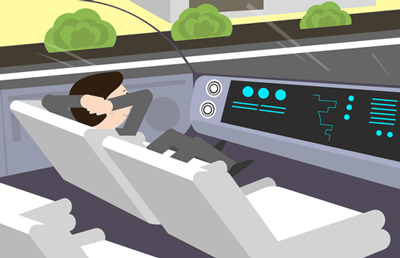Self-Driving Cars are emerging from a far-off science fiction future into a reality that’s just around the corner, and these new vehicles will change a lot more than just how we get to work and back.
By Jeffrey Cole
I have been talking about driverless cars for about ten years and ridiculed for most of that time. I was just getting used to seeing audiences’ eyes roll and glaze over as they thought I was pitching a Twilight Zone episode.
 Then something really interesting happened: people began to believe this wasn’t just a view of the future from The Jetsons.
Then something really interesting happened: people began to believe this wasn’t just a view of the future from The Jetsons.
Driverless cars are here, and even the biggest skeptics can see that something of compelling importance is about to happen.
The ability of cars to drive themselves without any human intervention is the most important social development of the next twenty-five years. It will change everything. It’s happening now (for example, with Uber testing self-driving cars in Pittsburgh and Phoenix), and it will be available to most people in three to four years.
I will use some of these columns to explore the thousands of ways driverless cars will change our lives. The changes will start with the decline, and end with the elimination, of drunk driving, road rage, texting while driving, and the awkward conversation with your parents or grandparents when you have to take the car keys away. Driverless cars will grant independence to the elderly who can no longer drive, as well as to the blind and disabled who have never been able to drive. With parent’s supervision, driverless cars will give freedom of movement to children to get to school, outside activities, and in the case of split households to the other parent.
However, driverless cars will not achieve their full and complete potential until no one is allowed to drive; that moment will not come for 20 years and is full of political and social minefields (imaging the signs reading, “you’ll take my car after you take my guns!”).
Most of the benefits of cars without drivers will be seen on the roads of big cities starting in a little over three years. The hurdles come not from the technology but from government fears and regulations. Since October 2016 Tesla has manufactured Level Five driverless cars. (Level Zero cars have no driverless features; Level Five do not need a human driver at all in any situation and may not even have a steering wheel). The question is how slowly or quickly governments will allow manufacturers to turn these features on.
Small Changes Lead to Big Changes
Once these cars become available in three years or so, they will quickly gain mass popularity. You’ll call for a car on your smart phone, and five minutes later the car will show up to take you wherever you need to go. Most compellingly, after dropping you off at the front door of your office, the movie theater, the mall or the football game, the car just goes away.
The magnitude of this change cannot be overstated. This is the massive appeal of driverless cars: they get you there and disappear. You’ll never again think about parking, fueling or maintenance. (I thought of this future at a recent concert where parking began at $32!)
When people experience the total freedom of a driverless car getting you somewhere and then disappearing, even very wealthy people who could own their own driverless cars will ask themselves, “Why would I want to park and think about the car?”
Once people see the appeal of not being attached to the car and the joy of not fighting traffic, they will quickly question the need ever to buy another car. In future columns, I’ll go into detail about possible pricing models for driverless car usage, the levels of cars we will use and how driverless car credits will become an important new form of currency.
One of the first impacts we will feel is that the driverless car will quickly become the second most important media and entertainment environment in our lives. We will consume more entertainment in the car than anywhere else other than the home.
This means cars will be designed and equipped very differently than the home. Some will be set up to watch movies and television; others will be set up for meetings. Instead of traveling to a store to get your hair cut, your stylist can pick you up at home and cut your hair while you’re on the way to work.
From Motels to Mobile Hotels
In a little over four years we will see one of my favorite driverless car innovations: the mobile hotel.
If your need to get from Los Angeles to San Francisco (a seven-to-eight hour drive) or New York to Chicago (about 10 to 12 hours), then you can still take a plane, train or drive yourself.
__________________________________________________________________________________________________
Most of the benefits of cars without drivers will be seen on the roads of big cities starting in a little over three years. The hurdles come not from the technology but from government fears and regulations. Since October 2016 Tesla has manufactured Level Five driverless cars. (Level Five do not need a human driver at all and may not even have a steering wheel). The question is how slowly or quickly governments will allow manufacturers to turn these features on.
__________________________________________________________________________________________________
But a more interesting and entertaining option (with no TSA long lines or delay) will be to have a driverless car show up at your house at 10 pm (or anytime you like). The windows will be blacked out (which will be legal because there is no human driver). A comfortable bed will be made up with a duvet, and there will be a chocolate on the pillow. At the foot of the bed there will be a screen, and your favorite programs will be ready to stream from the cloud.
You’ll tell the car what time you want to arrive. The car will travel no faster than the speed limit (will there even be speed limits when all cars are driverless?), but it can drive slowly to have you arrive at the time you selected. You’ll watch TV or movies as the car drives along. If nature calls, it will be similar to any road trip today: you’ll tell the car to stop at the next restroom.
When you arrive at your destination, if you don’t have a home or hotel room, then included in the costs of the mobile hotel (still lower than an air ticket) will be a refreshment center where you can shower, change clothes and get a meal.
If you’re thinking, “nobody would ever do this,” then think again. When we surveyed a representative sample of the U.S. population for our upcoming study on the future of transportation, 25% of our respondents said they would be open to checking into a driverless mobile hotel – and this is for a service that doesn’t even exist yet! Driverless mobile hotels will quickly become one of our preferred modes of travel.
This is just a taste of some of the ways driverless cars will change everything. We took a long look at everything about transportation, and you’ll be able to see some of our findings in a forthcoming report as well as in future columns right here.
__________

Jeffrey Cole is the founder and director of The Center for the Digital Future at USC Annenberg.
See all Analysis columns.
August 3, 2017

